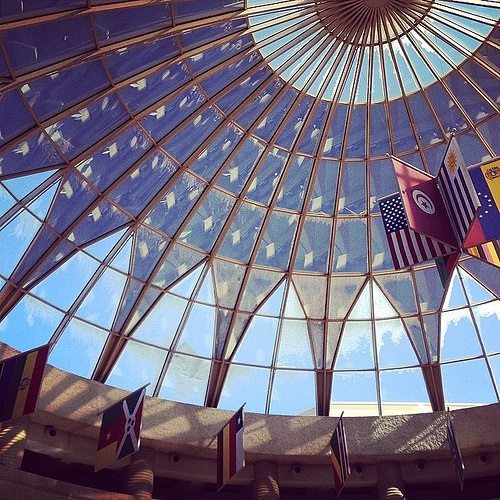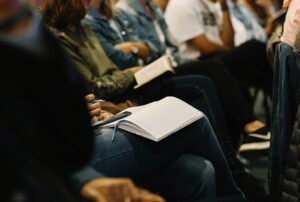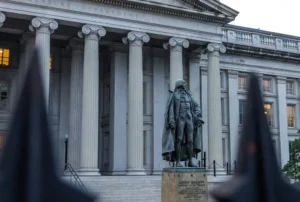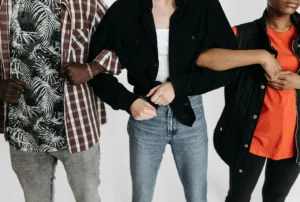
At 135,000 sq ft, the Charles H. Wright Museum of African American History, located in Detroit, is the largest museum devoted to African-American history and culture in the U.S. The central exhibit of the Wright is the 22,000 sq ft, 20-gallery exhibit, “And Still We Rise: Our Journey Through African American History and Culture,” covering the entirety of black history in North America, from the Middle Passage across the Atlantic Ocean as slaves to the achievement of emancipation and the progress of the Civil Rights era. Truly distinctive for taking on the scope and breadth of race as a factor in U.S. history, the Wright is by most accounts a valued asset not just to Southeastern Michigan, but for everyone who recognizes the importance of understanding how race was and still is a critical factor in our national psyche.
When the “Grand Bargain” of several Michigan and national foundations took shape to protect the Detroit Institute of Art from becoming a bargaining chip in the Detroit bankruptcy, some observers wondered whether foundations might also step up for the Wright, which—in a building owned by the city—had seen its financial support from the municipal government tumble in recent years, its operating budget shrink, and its staffing significantly reduced. In the nation’s largest African-American majority city, with the attention that major foundations have generated over the years, the Wright has nonetheless benefitted from philanthropic largesse, not just from giving from the Community Foundation for Southeast Michigan and the foundation arms of major Detroit-area corporations such as Ford Motor, General Motors, and Comerica, but from major national foundations—the Ford Foundation (grants of $2 million in 2007, $690,000 in 2013) and the Kresge Foundation (over $3 million between 2004 and 2013), just to name two.
But some $21,000,000 in foundation grantmaking to the Wright over a decade doesn’t quite compare to the commitments of 13 local and national foundations for as much as $370 million to prevent the DIA’s collection from being sold off to help the city pay for pension fund obligations. That multi-foundation commitment is on top of a special 10-year millage paid by Southeastern Michigan property owners that generates $23 million of the DIA’s $31 million annual budget.
The Detroit bankruptcy is a nearly unique situation, threatening the piecemeal disposition of the DIA’s assets. There doesn’t seem to be anything comparable that would present itself to the Wright to use its collection for the city’s hard-pressed pension funds, but the response of observers, particularly Rochelle Riley of the Detroit Free Press, questioning what might be done to help the Wright (see “Wright museum needs financial footing in Detroit bankruptcy plan” and “Who will step up to inspire the Wright museum’s salvation?”), leads to concerns about how well African-American museums are faring in the nation’s philanthropic and charitable worlds—and in government.
Challenges in the African-American Museum Landscape
Charleston, South Carolina was the port city where as many as 40 percent of all black slaves entered the pre-Civil War United States. Mayor Joe Riley is a champion for the proposed International African-American Museum, a 43,500 sq ft facility to cost $75 million. Riley plans to get $25 million from Charleston city and county sources, $25 million from the state legislature, and $25 million from private sources, with an expectation of starting construction in January of 2016. This year, he asked the state legislature for $12.5 million, anticipating a second $12.5 million next year; the legislature approved only $5 million, but that was significant improvement over the SC House’s initial authorization of only $250,000. Mayor Riley’s next strategy is to approach former president Bill Clinton.
From a brief review of self-identified African-American museums, it is clear that there are many more than most people realize. Most of them are relatively small, and several struggle—like many institutions of arts and culture—to find their way to sustainable financial futures. They also often appear to be remarkable community assets with important and widely recognized exhibitions and collections:
- The first of the African-American museums may be the African-American Museum in Philadelphia, which houses the extraordinary collection of photographs of Jack T. Franklin, who was a staff photographer for the nation’s oldest African-American newspaper, the Philadelphia Tribune.
- At the Reginald F. Lewis Museum in Baltimore, the “Strength of the Mind” gallery documents the art and education accomplishment of African-Americans in the United States.
- The California African American Museum has developed traveling exhibitions on historic black churches in four Los Angeles neighborhoods, the role of the black press in California, and the photographs the late Howard Morehead took of singer Ray Charles.
These museums mount exhibitions and programs that tell the stories that most Americans, black or white, won’t get elsewhere—certainly only minimally in mainstream museums of art, culture, and history. At the same time, many African-American museums confront financial constraints and challenges that aren’t easily solved. Samuel Black, president of the Association of African American Museums and director of African-American programs at the Senator John Heinz History Center, told USA Today, “When you talk about the status of the [black] museums, [their financial challenge is] the common thing.”
In one of the few academic papers in circulation examining the finances of black museums, Randall A. Williams and Michael Worth of the George Washington University put described the problem straightforwardly: “African American museums face a unique set of challenges that impede their efforts to achieve financial sustainability. African American museums are under funded due to historical barriers, cultural preferences for charitable giving, institutional youth, and a dearth of professional business and museum skills.” They cited the Underground Railroad Freedom Center in Cincinnati, a $110 million facility that opened in August 2004 that posted a $5.5 million operating deficit in its first 18 months and required a public commitment of $2-3 million in public sector operating funds annually to continue, the African-American Museum in Philadelphia which had to let most of its staff go in order to stay open, and the struggles of the Wright Museum itself for money and attendance.
“Virtually none are accredited with the American Association of Museums (AAM), few have endowments beyond a nominal size, and many have had to cut staff, programs, or projects in order to remain open,” Williams and Worth wrote. “African American museums need an internal reorientation of missions and staff, as well as an external infusion of funds and experience to address these challenges.”
Their paper, however is from 2007—before the election of America’s first African-American president, before the new wave of voter ID laws aimed at restricting the election turnout of black voters, before the tragedy of the shooting of black teens in Florida largely because the law allows them to be seen as public threats because of hoodies and loud music, before the Supreme Court’s decisions invalidating parts of the Voting Rights Act of 1965 and weakening affirmative action in college admissions, before the public bankruptcy of black-majority Detroit, and before the nation entered into and emerged from the depths of the worst economic recession since the Great Depression.
Are African-American museums simply troubled because of what they are and represent, or are their challenges no different than other cultural institutions emerging from the recession? How are African-American museums responding to their financial challenges? And is U.S. philanthropy playing a role to change the financial equation of African-American museums? These questions aren’t simply internal to the museum sector or even internal to the nonprofit and philanthropic sectors, but part and parcel of how American society is changing and responding to issues of race.
Distinctiveness in urban and rural locales
The B.B. King Museum and Delta Interpretive Center does more than honor the memory of bluesman B.B. King, his guitar “Lucille,” and his unique songs such as “The Thrill is Gone.” The museum is in Indianola, Mississippi, which has significance separate from King and his influence on blues guitarists here and rock guitarists such as the Beatles’ John Lennon. In 1962, inspired by a presentation by members of the Student Nonviolent Coordinating Committee, Fannie Lou Hamer took a bus to Indianola to register to vote. In return for trying to vote, she and her husband were fired from their jobs on a plantation near Ruleville, Mississippi. The next year, as a SNCC field organizer, Hamer was beaten so viciously for trying to desegregate a bus station that she was left permanently disabled. The history of B.B. King at his eponymous museum, which was designed to include a brick cotton gin where King worked as a young man, also reflects the history of blacks in the Delta, where major battles of the civil rights era were fought to shape the nation we are today.
The Wright is not only a distinctive museum, but in an unusual setting, on Warren Avenue only two blocks from Woodward Avenue, the spine of the likely revitalization of Detroit. (The Detroit Institute of Art is on Woodward, only a few blocks away from the Wright.) Kresge Foundation program officer George Jacobsen avers that if “any of the large cultural institutions…would be closed, that would be a major blow to all of our efforts on Woodward Avenue.” Kresge is a key player behind the planned construction of the M-1 light rail line on Woodward. “We’ve had an ecosystem mindset when it comes to cultural assets in Detroit,” Jacobsen said, noting a mindset shared with the New York-based Ford Foundation, whose new president, Darren Walker, came to the Wright and became a collaborative partner with Kresge and the Wright, focused on capacity-building around a development and marketing plan and a new arts management structure.
Placing the Wright in the middle of plans for the revitalization of Detroit’s Woodward Corridor is not far from the view of many black foundations. Brian J. Carter, the former deputy director and head curator of the Northwest African American Museum in Seattle, talks from the experience of several years at a start-up museum. “The challenge…[is] there are so many dreams and hopes that are pinned to an African-American museum. [When] you think of how many [traditional] museums aren’t telling an African-American-centric story, passions and dreamed are heaped onto this place.” He adds, “you have a lot of museums that want to be all things to all people, one modest institution trying to meet those dreams.” In part, however, it is not just the dreams of the museums, but the dreams that their communities have attached to them and expect them to explain, articulate, and live out. “We’ve always struggled,” Carter says, “with how do you take this visceral need of people coming in saying, ‘please tell my story.’”
In the end, unless the museum is large, most of the African-American museums are really community institutions, as much parts of their communities as anything else. In that context, their functions and their survival are rooted not just in how much they are able to generate access to the likes of Kresge and Ford, but what they do for and how they connect with their local communities.
Sign up for our free newsletters
Subscribe to NPQ's newsletters to have our top stories delivered directly to your inbox.
By signing up, you agree to our privacy policy and terms of use, and to receive messages from NPQ and our partners.
A smaller example is the B.B. King Museum and Delta Interpretive Center, operating with roughly a million dollar annual budget. Dion Brown, the executive director, is familiar with the challenges of recruiting and retaining development staff and generating fundraising plans like the efforts underway at the Wright. However, he sees different strategies for small foundations like the B.B. King Museum and others. “A lot of our [revenue] comes from our programming, specifically tied to this area,” Brown says. “We have one partnership which helps us provide after-school program…Mississippi has a serious problem with literacy and obesity, so we tackle those issues…Other areas in the Delta see what we’re doing and pay for the program.” The “money provides a service,” Brown says, and the museum “gets attention and support” in return.
It happens at the Wright no less than the B.B. King. At the Wright, there are weekly “Hustle for History” dance lessons, giving the Wright the feel of a deeply rooted community-based institution that also happens to be a nationally recognized African-American museum (Detroit News, March 4, 2014). The Wright’s CEO, Juanita Moore, echoes Brown at the B.B. King in the Delta: “African-American museums have always been ahead of the traditional museum in serving their audiences,” she says. “Part of that is because African-American museums have been built around people as opposed to objects.” To think of African-American museums as troves of artifacts as opposed to community institutions protecting and preserving the stories and cultures of African-American neighborhoods is to truly misunderstand what these places do.
Intersections with government
Harriet Tubman’s shawl, a gift she received from Queen Victoria, and her personal hymn book, from which prayers and songs were used to warn runaway slaves that it might be time to leave or hide as they received her help on the Underground Railroad, are two of the artifacts that will be displayed at the National Museum of African American History and Culture, the newest Smithsonian Institution museum to be created in Washington, D.C. President Obama and the First Lady joined actress Phylicia Rashad for the groundbreaking in February, but will it boost local and regional African-American museums or compete with them for needed support?
For local African-American museums, the level of support they might get from the federal government is limited. The funding available from the Institute of Museum and Library Services, a relatively little known federal agency, has been used by many museums in creative ways, but the money isn’t just for African-American museums; it’s been spread among many potential claimants. The specific program in the IMLS budget for African American History and Culture is small, roughly about $1.4 million, but even with other grant programs in the Institute, the federal moneys do not represent a source for bailing African-American museums out of whatever financial problems they might face. As with Mayor Joe Riley’s efforts for an African-American museum in Charleston, part of the financial response for many will be from state and local government sources.
For the Wright, which has historically had a long though declining relationship with the City of Detroit, there are realistic limitations on what can and should be expected from a municipal government that is out of money and struggling to provide basic services. Kresge’s Jacobsen doesn’t delude himself or his colleagues regarding what the Wright might expect going forward. “On the municipal level, big x factor post bankruptcy…[will be] the very practical question of what the [Mayor Mike] Duggan administration is doing,” he wonders. “I can’t imagine that they start funding the arts, but are there better ways for arts organizations to prove their relevancy in Detroit, [for example working with] schools largely don’t have arts programming.” He challenges arts organizations in general, the Wright and others, to think about building a different relationship with the community in the future.
It isn’t just a matter of severely troubled municipalities like Detroit. In Macon, Georgia, the Tubman African American Museum is a well-respected museum with a national profile. Nonetheless, the Macon-Bibb mayor just zeroed the museum out of the local government’s 2015 budget. As a community institution, the Tubman isn’t the only organization to be slashed in the budget. Others to be cut include a theater, adult literacy programs, the county’s economic opportunity office, and the Middle Georgia Community Food Bank. While there might be larger institutions like the Wright with important, high-profile functions to play in scenarios like Detroit’s Woodward Corridor plans, most of these institutions are small and function not like the Detroit Institute of Art, but like community-based nonprofits—and will receive public support as a result of organizing and mobilizing their communities of supporters.
Thinking about African-American museums, like other nonprofits, as self-sustaining business enterprises misses the point. They are nonprofits and have to organize for support. In St. Petersburg, Florida, the Housing Authority is contemplating ending its long-term leasing of a building for the Dr. Carter G. Woodson African-American Museum as part of a Housing Authority plan to get rid of its commercial real estate holdings. Although entirely volunteer-run, the museum has been the beneficiary of community residents protesting against the Housing Authority’s plan. The Authority’s director hinted that the Woodson museum wasn’t quite a fully functioning museum, but community residents and museum volunteers countered with information that the Woodson had had 23 exhibits, 11 youth events, four movie premieres, six book signings, and 26 community engagements of one sort or another since 2008—all without paid staff.
African-American museums as community institutions
“The Tubman African American Museum…is one of the state’s leading providers of arts instruction and arts-based learning opportunities—both at the museum and through the Tubman’s innovative school and afterschool outreach programs. Its educational programs, events and outreach offerings provide unique educational opportunities for at-risk youth and instruction in the visual and performing arts for children who otherwise would not have access to these resources,” writes Andy Ambrose for The Telegraph. “This is exactly the kind of empowering and engaging educational experiences that are critically needed in Bibb County, where only a little over one-half of the students in the public school system graduate from high school and almost two-thirds are considered academically at risk.”
A recent review of the funding recipients listed in the BMAfunders database —a little over 2,700 grants directed at addressing issues concerning black men and boys—reveals how many recipients are not necessarily led by people of color. It isn’t that the organizations are not doing good work—one presumes they are. But the relatively small proportion that are led by people of color, much like the small proportion of foundations that are led by CEOs and trustees who are people of color, reflects a problem that goes beyond the specific issue of black men and boys in the BMA database or museums in this discussion.
For foundations, it is a matter of grantmaking institutions largely led and governed by whites trying to discern the significance of African-American museums to their communities and to society overall. The proportion of foundation CEOs who are persons of color actually decreased between 2011 and 2012; in its 2012 report, the Council of Foundations reported that the proportion of foundation CEOs of color decreased from 9.2 to 8.4 percent and as executive vice presidents or assistant directors from 12.9 to 11.9 percent. Although the foundation CEO proportion is above where it was in the mid-1990s, it seems to have stagnated in recent years. Regarding foundation trustees, a recent report from the Greenlining Institute examined the composition of foundation trustee boards and concluded that racial diversity had largely stagnated between 2009 and 2012. For foundations and for African-American museums, it is impossible to divorce crucial issues of race, particular who makes decisions about the allocation of resources from one institution to another and one community to another, from their societal context.
Redell Hearn, the former museum curator of the California African American Museum who has more recently been teaching museum studies at Johns Hopkins University, puts the issue of black museums squarely into a context of how black museums and other black institutions function in society.
“What’s missing is an honest conversation about notions of culture in general, what is missing is an honest conversation about museums, about African-American museums in this country…so that when you ask whether foundations will step in, it’s not a conversation based on emotion, but based on fact,” she challenges. “It may be a fact that you have an African-American museum in a large city, but you don’t have the finances or the support. Is it more important to have a shell of an African American museum or to put the resources elsewhere?”
Hearn sees possibilities other than having empty shells with little going on. For example, she is impressed, she says, with a consortium of African-American museums in Florida, citing the role of the John Gilmore Riley Museum in Tallahassee taking the lead role in creating—with the help of an Institute of Museum and Library Services grant—the Florida African American Museum Exchange Program, providing technical assistance and mutual assistance within a network of more than a dozen African-American museums in the state. “You can’t sustain museums without a commitment from the community of the museum,” Hearn says, “the community whose stories are being told.”
Ultimately, for whatever a foundation like Kresge or Ford might be able to deliver to African-American museums, Hearn thinks that the black museums have to organize themselves to better sort out who and what they are and to build stronger relationships with the communities they serve and represent. At the time she spoke to Nonprofit Quarterly, Hearn noted that she had no black students in her museum studies classes at Johns Hopkins, and perhaps only three black students in her JHU museum studies classes over five years. Seven years after the report from Williams and Worth on black museum finances, six years after the election of Barack Obama as president, it still comes down to a core issue: “The bigger, bigger, bigger picture in this conversation is that race is still an issue in this country,” Hearn says, “it’s still a larger part of our culture.”
If communities think that African-American history, culture, and communities are simply not all that relevant, if race were to slip into the recesses of public understanding and debate with the incorrect notion that American society is somehow post-racial, the future path of African-American museums will be one where some institutions capture funding and others don’t. If race is recognized as a legitimate and continuing concern in our society, African-American museums and the communities to which they are accountable have a different conversation to pursue—for museums being constructed on the National Mall and smaller museums in neighborhoods around the nation speaking to potential charitable and philanthropic donors.
A board member of the Association of African American Museums, Schroeder Cherry, put Hearn’s challenge in different words, focused on the Wright, but with the same implications: “Is African American history and culture considered as important as the legacy of European culture in Detroit?…It’s a conundrum, whose culture is worth saving, whose culture is deemed important to save, [and] who are the connectors within the museum” to the resources that can build the capacity and sustain the long-term finances of large museums like the Wright and smaller African-American museums, wherever they might be. Kresge and Ford are responding with capacity-building support for the Wright, partly as an iconic institution located in the midst of defining the future of bankrupt Detroit, but the larger issue will be for the African-American museums elsewhere and how they make their cases, not just to foundations, but to mobilize the communities whose stories they preserve, tell, and value.












